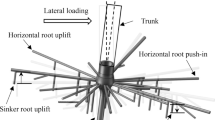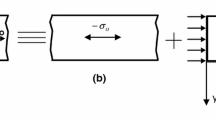Summary
Roots which grow down through a seed-bed and encounter a strong, untilled sub-soil beneath may be deflected horizontally. They will continue to grow horizontally along the top of the sub-soil either until the seed-bed dries out and the roots wilt and cease elongating, or until they find some path of low resistance down through the sub-soil. A major source of such paths is vertical cracks in the sub-soil.
Model experiments were done with artificial impenetrable sub-soils containing parallel cracks with widths in the range 0.5–3 mm. Roots of pea and wheat were grown down through beds of aggregates to encounter the artificial sub-soil at random positions. The roots were deflected horizontally until they encountered the vertical cracks. The proportions of roots which entered the cracks were found to decrease strongly with decreasing crack width and increasing (more perpendicular) angle of incidence between the root and the crack.
The experimental results were combined with the results from computer simulation studies which gave the proportions of roots encountering cracks at various angles with both hexagonal and parallel crack patterns. This showed that parallel crack patterns should enable a greater proportion of roots to enter the cracks than hexagonal crack patterns. Monocotyledonous plants which have several seminal root axes per plant have a statistical advantage over dicotyledonous plants which have only one seminal axis per plant with regard to crack entry.
Similar content being viewed by others
References
Dexter A R 1986 Model experiments on the behaviour of roots at the interface between a tilled seed-bed and a compacted sub-soil. I. Effects of seed-bed aggregate size and sub-soil strength on wheat roots. Plant and Soil 95, 123–133.
Edwards W M, Fehrenbacher J B and Vavra J P 1964 The effect of discrete ped density on corn root penetration in a planosol. Soil. Sci. Soc. Am. Proc. 28, 560–564.
Elkins C B, Thurlow D L and Hendrick J G 1983 Conservation tillage for long-term amelioration of plow pan soils. J. Soil and Water Cons., May–June, 305–307.
Fox W E 1964 Cracking characteristics and field capacity in a swelling soil. Soil Sci. 98, 413.
Hasegawa S, Thangaraj M and O'Toole J C 1985 Root behaviour: field and laboratory studies for rice and non-rice crops.In Proc. Int. Workshop on Physical Aspects of Soil Management in Rice-based Cropping Systems. Int. Rice Res. Inst., Los Baños, Philippines.
Heinonen R 1982 Alleviation of soil compaction by natural forces and cultural practices.In Proc. Int. Conf. Land Clearing and Development. Int. Inst. Tropical Ag., Ibadan, Nigeria.
Hoogmoed W B and Bouma J 1980 A simulation model for predicting infiltration into cracked clay soil. Soil Sci. Soc. Am. J. 44, 458–461.
Johnson W C 1962 Controlled soil cracking as a possible means of moisture conservation on wheat-lands of the South-Western Great Plains. Agron. J. 54, 323–325.
Lachenbruch A H 1961 Depth and spacing of tension cracks. J. Geophys. Res. 66, 4273–4392.
McGowan M, Wellings S R and Fry G J 1983 The structural improvement of damaged clay subsoils. J. Soil. Sci. 34, 233–248.
O'Callaghan J F and Loveday J 1973 Quantitative measurement of soil cracking patterns. Pattern Recognition 5, 83–98.
Oades J M, Lewis D G and Norrish K 1981 Red-brown earths of Australia, Waite Agric. Res. Inst. and CSIRO, Adelaide.
Russell E W 1973 Soil Conditions and Plant Growth, Longman, London.
Sharma R B and Verma G P 1977 Characterization of shrinkage cracks in a medium black clay soil of Madhya Pradesh. I. Pattern and size of cracking in relation to vegetative covers. Plant and Soil 48, 323–333.
Stefanelli G 1979 Tensioni interne, contrazioni, fessurazioni nei terreni argillosi per diminuzione di umidita. Revista di Ingegneria Agraria 9, 117–126.
van de Graaff R H 1978 Size of subsoil blocky peds in relation to textural parameters, depth and drainage.In Modification of Soil Structure. John Wiley, Chichester.
White E M 1966 Subsoil structure genesis: theoretical consideration. Soil Sci. 101, 135–141.
White E M 1967 Soil age and texture factors in subsoil structure genesis. Soil Sci. 103, 288–298.
Whiteley G M and Dexter A R 1981 Elastic response of the roots of field crops. Physiol. Plant. 51, 407–417.
Whiteley G M and Dexter A R 1982 Root development and growth of oilseed, wheat and pea crops on tilled and non-tilled soil. Soil and Tillage Res. 2, 379–393.
Whiteley G M and Dexter A R 1983 Behaviour of roots in cracks between soil peds. Plant and Soil 74, 153–162.
Author information
Authors and Affiliations
Rights and permissions
About this article
Cite this article
Dexter, A.R. Model experiments on the behaviour of roots at the interface between a tilled seed-bed and a compacted sub-soil. Plant Soil 95, 135–147 (1986). https://doi.org/10.1007/BF02378859
Received:
Revised:
Issue Date:
DOI: https://doi.org/10.1007/BF02378859




